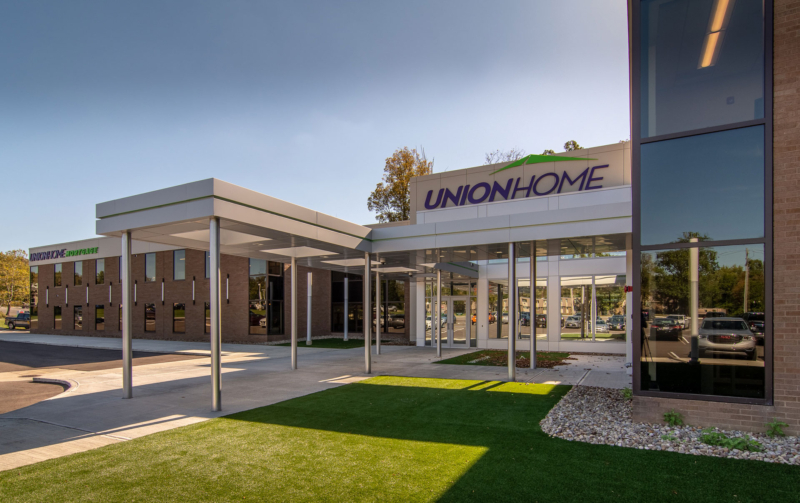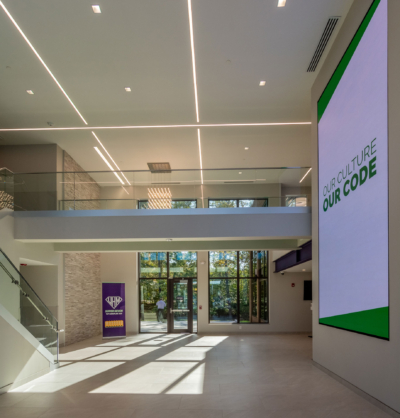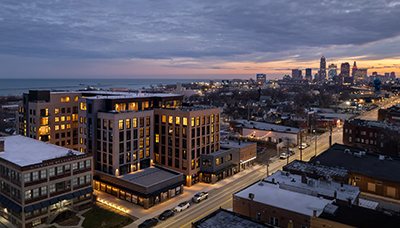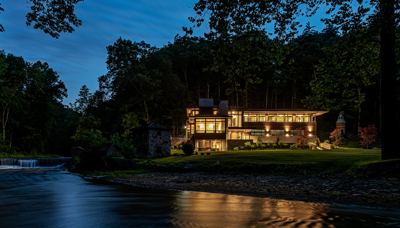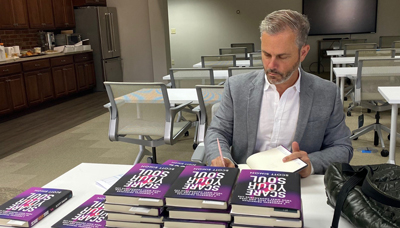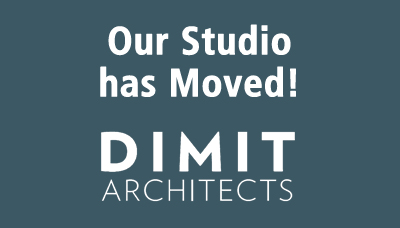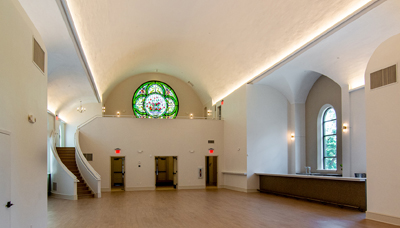On the Move in Strongsville
Union Home Mortgage answers space needs with renovated facility at Strongsville campus
Originally published in Properties Magazine, November 2021. Story by Mark Watt
“Everything says something,” remarks Bill Cosgrove, owner/CEO of Union Home Mortgage (UHM), as he reflects on the latest addition to the company’s national headquarters in Strongsville. “That’s something I’ve learned with each design and construction project on our campus. I’ve come to the conclusion that everything says something. When it comes to our buildings, I want to make sure that every detail of the design and every piece of technology supports our people, our culture and everything that we aspire to represent.”
That attention to detail is on full display at the newly opened $12 million West Building, which serves as a centerpiece of UHM’s 120,000-square-foot, three-building campus along Sprague Rd., just east of the I-77 and Pearl Run interchange. Originally constructed as a research center for Dow Chemical and more recently home to the now defunct ITT Technical Institute, the West Building has been renovated into a “state-of-the-art mortgage hub for business, education and culture,” per company literature.
Led by TCV Development as design-assist construction manager and Dimit Architects, the renovation effort has transformed the 65,000-square-foot, two-story building from a dated relic of the ‘70s into a modern work environment that is equipped to evolve with changing technology needs over the coming decades.
The multi-purpose building houses a high-tech training center, a full-service corporate café and fitness facility, in addition to offices for the company’s marketing and innovation departments and its Consumer Direct call center.
“I’m 59 years old and when I started my career, there was no talk of workplace culture,” Cosgrove says. “There were no expectations beyond being provided a phone and a desk. I think the professional of today expects a lot more from a work environment though, and I feel we’ve raised the game with what we have created here.”
High-growth = space needs
The West Building renovation is a reflection of UHM’s high-growth model, Cosgrove says. “We simply needed more space,” he says. “The mortgage banking industry has turned into a scale game. You can’t be small anymore and survive. In order to build a world-class organization, you have to expand operations and that’s what we’ve done here and all around the country over the years.”
As Cosgrove explains, UHM was founded in 1970 but after its first couple of decades, the company’s progress had stalled. “The company was almost on its death bed around 1990,” he explains. “I came onboard in 1994 and when I purchased the company in 1999, there were 30 people here. We’ve been building the organization ever since.”
Today, the full-service retail, wholesale and consumer direct mortgage banking company operates with more than 150 satellite offices in 44 states and employs close to 1,900 individuals. That includes nearly 390 associates hired at its Strongsville campus since March 2020 alone.
“Our continued growth is a reflection of the residential market in America with a shortage of housing and historically low interest rates,” he says. “Housing has been a hot industry and our organization has grown alongside it. We have a tremendous amount of momentum and ultimately that momentum fueled the need for additional space here on our main campus in Strongsville.”
Collaborative working process
To meet those growth needs, UHM turned its sights toward the former ITT building, immediately west of its corporate headquarters. For a number of years, the company had leased a portion of the building as swing space, and shared the facility with several other commercial tenants. In 2018, the company purchased the building and began assessing possibilities for renovation with assistance from Dimit Architects and TCV Development.
“It was a solid building – steel-framed, bar joist, concrete deck, masonry exterior walls – but the systems were in bad shape,” says John Tellaisha, associate principal with Dimit Architects. “It was also very dated.”
Construction started with some exploratory demolition in late 2019. Ultimately, the scope of the project was a total gut, Tellaisha says, requiring all new mechanical, electrical, plumbing systems, plus a new roof and all new windows systems, including frames. All interior partitions were removed, which essentially created a blank slate to accommodate new programming. The project, completed this summer, also included punching in 18 additional windows on the north side of the building, as well as a new entry addition.
“The entry point to the building wasn’t very clear, so we saw an opportunity to tear off some unusual, dated brick elements and build a two-story lobby addition to create a sense of arrival,” Tellaisha says. “We were able to push out the entry toward the front of the building and use glass and aluminum panels as a contrast with the brick exterior. What we created is a much more welcoming glassy entrance with an aluminum panel canopy that serves as a focal point.”
A flexible, LED lighting system is incorporated within the canopy, allowing the company to make the entryway glow at night with its corporate colors of purple and green, or any other color desired. The system pairs with a series of light bollards flanking the entryway, plus a number of sconces along the building’s exterior.
“It’s a very elaborate LED system by Acolyte that syncs the preset UHM colors of the building’s east canopy, the main canopy, the monolith uplight and the glass bridge uplighting all in unison” explains Thad Vasko, owner of TCV Development. “That detail, along with a lot of other design features here, was an idea that came from Bill Cosgrove. He travels a lot and throughout the project he would come back with photos of design ideas that he liked.”
Adds Tellaisha, “It was a very collaborative, interactive working process. We’d start with Bill’s ideas and then try to build from there. The idea of having a campus here was very important to UHM and that was factored in. We wanted the building to fit in and harmonize with the existing facilities to create a corporate campus feel. At the same time, they wanted this new building to stand out and create a strong first impression that would reflect the company’s culture.”
World-class lobby
Stepping inside the front doors, visitors are greeted with a lofty, two-story atrium that is designed to communicate the Union Home Mortgage brand. Immediately grabbing attention is a 20-foot-high by eight-foot-wide, $350,000 high definition LED video display board.
“It’s a state-of-the-art, real time video wall,” Cosgrove says. “We aspire to be a world class organization in everything we do and I think that video wall communicates the message right out of the gate.”
The lobby includes a feature wall of panelized stone product, a decorative chandelier and a flooring system of two-foot by four-foot ceramic tiles, plus walls of glass overlooking a wooded ravine to the south.
A flight of stairs leads to the second floor where a striking glass bridge links the east and west portions of the building. The glass connector incorporates an opaque finish on top for privacy and slip resistance, while its underside glows with concealed, indirect LED lighting.
“The lobby has a world class look, but it’s actually very economical as far as materials are concerned,” Vasko says. “That’s a reflection of our design-assist approach here, and you’ll notice it throughout the entire building. Throughout the entire project, we worked hand in hand with the architect developing details within the budget and project scope. We had a lot of input from the subcontractors as well. It was a very collaborative way to build the project and allowed us to complete it in the most cost-efficient manner.”
State-of-the-art training center
Central to the programming of the facility is a 10,676-square-foot training center that occupies the majority of the first floor.
“We recruit talent from all over the country and once they’re hired, we train them over the course of a week and transition them into the company,” Cosgrove says. “The West Building is home to this entire process, so it truly represents a first impression of our company for mortgage professionals from throughout the country. And then they’ll come back once or twice a year for continued training. Some portion of the training center is used every single day. Because of that, the design is intended to make this as much of a community center as an office building, which is why it also includes a workout facility, café and lounge spaces.”
The facility includes a series of flexible training rooms, several of which are equipped with operable partitions to accommodate meetings of different sizes. The largest training space is Cosgrove Amphitheater, a lecture hall with a pair of drop-down video screens and seating for up to 100 individuals. All meeting rooms are equipped with high-end audio/video and teleconferencing technology that allows for seamless hybrid in-person and remote instruction.
Nearby, a sound-insulated media room is equipped with a green screen and specialized lighting for filming commercials or training videos.
In the core of the training center is an open lounge area with a kitchenette and a mix of high-top tables and soft seating for informal meetings or downtime between training sessions.
“The refrigerators [in the lounge] are available to anyone, for instance if someone wants to store leftovers to take back to their hotel,” says Brian Coleman, vice president with Union Home Mortgage. “We host people from all over the country, so we also have a luggage storage room and huddle rooms where people can unwind or charge their phones or laptops.”
The lounge includes a floating ceiling that serves to attenuate sound and conceal utilities, while adding visual interest as well.
“If you look at the ceiling, you’ll notice that we repurposed an existing cable tray that picks up all cables from the second floor and runs across the ceiling like a set of railroad tracks,” Vasko says. “It keeps everything organized and clean, but it also allows it be easily reconfigured as needed.”
Also tucked into the ceiling in the lounge and throughout the training center are a series of variable refrigerant flow (VRF) systems, Vasko notes. “About three-quarters of the building is heated and cooled by a traditional rooftop system, but in the training center we’ve implemented VRF systems, that are essentially mini-split systems. With educational spaces, rooftop units can struggle because some rooms may need cooled while others need heat. VRF systems are ideal for this type of space. They also eliminate the need for large ductwork, which allowed us to open up the ceilings.”
Immediately next to the training center is an executive boardroom suite, which includes Cosgrove’s office. The executive boardroom incorporates directional antennae and cameras that follow a speaker as he or she moves around the room.
Also adjacent to the training spaces is a fitness center, equipped with a combination of free weights, resistance machines, exercise bikes and more. Men’s and women’s locker rooms are furnished with integrated LED strip light fixtures, wall-mounted trough sinks and Dyson hand dryers.
Tucked away on the west end of the building is a high-bay storage area, with racks of computers prepped to ship to associates across the country, as well as surplus office furniture.
Dee’s on Dow
Also on the first floor, occupying the eastern portion of the building, is Dee’s on Dow, a full-service café that is named after Cosgrove’s late mother. The space includes a variety of comfortable seating for diners, with wood-grid floating ceilings and earth-toned tile flooring. Dividing screens in the space feature translucent resin with embedded plants, selected to tie in with nature views to the south.
“One thing that every human being can relate to and always brings people together is food, so we built a professional five-star kitchen here and we have a license as a restaurant,” Cosgrove says. “We provide wonderful meals for breakfast and lunch, and soon we will also have dinners available for take-out so that our partners can buy entire meals for the families at a discounted cost. What we are charging is about the same as the cost of the ingredients themselves. We’ve essentially built a community center here and I think it has taken the culture in our organization to a new level.”
At its core, UHM’s culture is premised on the idea that people come first – and that investing in the professional and personal wellbeing of its team members enables the company to better serve its customers, Cosgrove says.
Second floor offices
A majority of the building’s second floor houses the company’s Consumer Direct call center with rows of cubicles occupying an approximately 15,888-square-foot sales floor. The space is supported by a dozen huddle rooms and a quick-service café with vending machines, microwaves and coffee machines.
The balance of the second level accommodates the company’s marketing and innovation departments with open workstations and a pair of offices. Throughout, punches of green and purple can be seen in feature walls, custom carpeting and furniture.
Rewarding renewal
Reflecting on the completed project, Cosgrove says that feedback from partners and the surrounding community has been extremely positive. “The response has been phenomenal,” he says. “We had a grand opening in September with about 350 guests and everyone was blown away. The mayor of Strongsville and a lot of other local leaders told us they were stunned by what has been accomplished here, especially considering the previous condition of the building. Our partners love it too.”
Vasko notes that the project’s success is the result of a commitment to collaboration. “It was a feel-good project from the start,” he says. “John [Tellaisha, of Dimit Architects] and I were looking to protect the owner’s interests, and Bill [Cosgrove] was extremely hands-on and involved in every decision, which ensured that the project would reflect what he wanted out of the building.”
The project is also a testament to the value of a design-assist methodology, Vasko adds. “That approach allowed us to economize the project at every step and with each decision that was made,” he says.
Tellaisha agrees. “It was a smooth-running project,” he says. “Problems didn’t get overblown. They were just solved.”
Cosgrove reiterates that he’s particularly happy that UHM was able to bring new life to an aging facility. “To me, renovating is more rewarding than building from scratch – to take an old building that had come into rough times and to revitalize it and transform it,” he says. “We couldn’t be happier with this project.”

